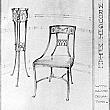Pompeiian Wrought Metal
by William R. Hoffmann
 Pompeiian design and decoration lends itself admirably to the fabrication of modern and traditional furniture in wrought metal. The artistry of the Pompeiians and the early Egyptians has never been excelled. This is particularly true in metal work. Recognized as one of the foremost centers of Roman culture and basking in luxury, their artistic senses were highly developed.
Pompeiian design and decoration lends itself admirably to the fabrication of modern and traditional furniture in wrought metal. The artistry of the Pompeiians and the early Egyptians has never been excelled. This is particularly true in metal work. Recognized as one of the foremost centers of Roman culture and basking in luxury, their artistic senses were highly developed.
Discovery of the Roman city of Pompeii in 1754 stimulated an artistic interest that had a definite effect on 18th century English furniture designers. The Adams brothers in England incorporated many of the Pompeiian motifs in their architectural renderings and furniture adaptations. In France the Pompeiian influence was not discernable until the Louis XV period when people tired of the sensuous lines of this feminine style and sought a more enduring form of line.
With the advent of modern manufacturing methods such as die-casting and the bending and shaping of tubular and flat chrome-plated steel, metal furniture embodying Pompeiian influence is being re-created, and production methods have brought this type of furniture within the reach of the average consumer’s pocketbook and desires.
The illustrations of the chair and the plant-stand are exquisite examples of modern adaptation of Pompeiian design. Furtherance of modern metal furniture development has been possible through the introduction of contemporary materials. New accents are permitted in a combining of wood, glass, copper, cork and chrome steel, and new discoveries in the fabrication of light weight metals allows many unusual and interesting forms to be developed.
William “Bill” Hoffman, Camoufleur to Medalist, by editor of The Sketch Book
 Beginning his career with architectural aspirations, Hoffmann enrolled in the Cooper Union Institute, New York, in 1916. During WWI “Bill” exhibited his artistic wares in the creating of camouflage for the protection of AEFers.
Beginning his career with architectural aspirations, Hoffmann enrolled in the Cooper Union Institute, New York, in 1916. During WWI “Bill” exhibited his artistic wares in the creating of camouflage for the protection of AEFers.
From Cooper Union he moved to the Beaux Art Institute, and in 1920 and ’21 achieved the distinction of being a Beaux Art medalist. His experiences in the realm of furniture designing had their inception with that fountain head of furniture craftsmen, W. & J. Sloane.
Following several years of intensive training in the designing of interiors and furnishings, Hoffmann migrated to Grand Rapids, and for over a decade produced successful designs for Robert W. Irwin Co. Severing his connections as staff designer with Irwin four years ago, “Bill” has since created designs for such concerns as Johnson, Handley, Johnson Co. and Berkey & Gay of Grand Rapids, and Saginaw Furniture Shops of Saginaw, Michigan.
Versatile, talented and technical, Hoffman is equipped with an understanding and knowledge of furniture design as related to modern production methods and merchandising perception, only possible to one thoroughly founded in design fundamentals.
Both articles excerpted from Fine Furniture, December 1936, page 24

 facebook
facebook
